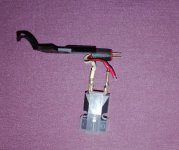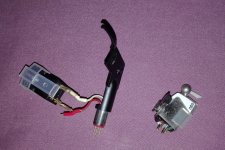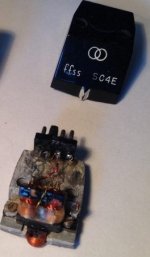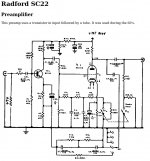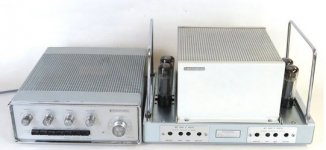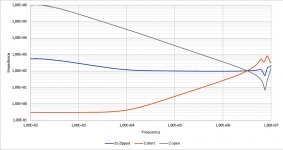The DL-103 is a nice generator though a bit high internal resistance. I don't love spherical tips, and the Denon MC that I currently use has an elliptical (or possible line contact, depending on who you ask) stylus and less than half the internal impedance of a 103. However the DL-103 plays nice music and has been doing so for a long time.
I'm sure replacing the flimsy plastic body with something more substantial would reduce resonances and improve things sonically. (And, yeah, my Denon DL-311LC has an aluminum body from the factory.) Retipping with a better stylus profile would make me feel better, but I can't swear you would hear a difference.
How much is it worth to re-body a DL-103? I don't know, only the buyer can decide.
I'm sure replacing the flimsy plastic body with something more substantial would reduce resonances and improve things sonically. (And, yeah, my Denon DL-311LC has an aluminum body from the factory.) Retipping with a better stylus profile would make me feel better, but I can't swear you would hear a difference.
How much is it worth to re-body a DL-103? I don't know, only the buyer can decide.
Not a patch on my old Decca FFSS moving coil
I don't think Decca ever made MC carts, they are moving iron (unique, but still MI not MC).
I think @billshurv gets his MC’s re-tipped by a guy in Russia - he could help.
Dmitriy in Vladivostok also retipped my broken Ortofon MC15 Super. I swear one of these days I will mount it and give it a listen. (I broke it the first time I mounted it, so am still nervous about it.)
The DL-103 is a nice generator though a bit high internal resistance. I don't love spherical tips, and the Denon MC that I currently use has an elliptical (or possible line contact, depending on who you ask) stylus and less than half the internal impedance of a 103. However the DL-103 plays nice music and has been doing so for a long time.
I'm sure replacing the flimsy plastic body with something more substantial would reduce resonances and improve things sonically. (And, yeah, my Denon DL-311LC has an aluminum body from the factory.) Retipping with a better stylus profile would make me feel better, but I can't swear you would hear a difference.
How much is it worth to re-body a DL-103? I don't know, only the buyer can decide.
Agree with you, I keep exploring different options :
These are all of different woods and shapes.
"fix the cartridge with an adhesive" (and where is the rosonance of the set?)
"This one has the advantage that you can reuse the cartridge body with other shells" (and who would do that if not just for snobbery?)
I believe that this is the best solution for a correct firmness of the set and without taking risks.
It is also higher than the price of the cartridge, if we are willing to spend 1000 U $ S, I believe that a current MC of equal or superior performance costs that money.
Audio MusiKraft Polished Lithium Shell for Denon DL-103 - Shells - Audio MusiKraft
So, the ideal for me would be to get this gadget, simple and effective, reasonable cost. (85 U $ S)
'The Cap'
I have found the answer to my questions about clicks and pops in tube preamps.

Pops, clicks and phono pre design. | Steve Hoffman Music Forums
Can a phono preamp amplify ticks and pops? | Steve Hoffman Music Forums
Pops, clicks and phono pre design. | Steve Hoffman Music Forums
Can a phono preamp amplify ticks and pops? | Steve Hoffman Music Forums
The DL-103 is a nice generator though a bit high internal resistance. I don't love spherical tips ..............
Yes, I know. Denon DL 103 R has 14 Ohms against 40 Ohms, but still has a spherical spike.
That is why the guys at Amazon compare it to these others !
https://www.amazon.com/-/es/Denon-D...p/B000OC1QTS#HLCXComparisonWidget_feature_div
I chose the spherical puá for the reasons that I detailed previously, you did not understand me? A spherical needle will not track as many details but to me they are insignificant.
Minimizing clicks and pops is my goal.
I hope you understand my bad English this time, cheers Dimitri.
Last edited:
Senor, one must move with the times. I have little idea how good the Internet connection is in Argentina. 
But rather than messing around with such ancient technologies as Record Players and Cartridges, merely subscribe to "Deutsche Grammaphon"
DG Premium - Your Key to Classical Music - Classical Concerts
The World then becomes your 24 or 32 bit Oyster. You follow?
But rather than messing around with such ancient technologies as Record Players and Cartridges, merely subscribe to "Deutsche Grammaphon"
DG Premium - Your Key to Classical Music - Classical Concerts
The World then becomes your 24 or 32 bit Oyster. You follow?
Ha, here the connections are fast if you sell a kidney, but I have 100 MB / S at the price of a few liters of blood per month and it is enough ...
Thanks for the link, but with my subscription to Spotify that I maintained for three years, and that now I have canceled because it did not connect, I already have enough in the world of bits.
I migrated to Tidal, which went online right away and so far works fine, although it still takes me longer to find a certain track than it does to get up from the couch and choose the CD or vinyl I have in mind. Nothing intuitive.
Look at this news from friend Zuck, (friend of money), do you think they are good omens for the world? (you will have to suffer like me using the GT, gg)
Cual es el objetivo que tiene Facebook cambiando su nombre por Meta | Una serie de escandalos tiene como protagonista al gigante de las redes sociales | Pagina12
Thanks for the link, but with my subscription to Spotify that I maintained for three years, and that now I have canceled because it did not connect, I already have enough in the world of bits.
I migrated to Tidal, which went online right away and so far works fine, although it still takes me longer to find a certain track than it does to get up from the couch and choose the CD or vinyl I have in mind. Nothing intuitive.
Look at this news from friend Zuck, (friend of money), do you think they are good omens for the world? (you will have to suffer like me using the GT, gg)
Cual es el objetivo que tiene Facebook cambiando su nombre por Meta | Una serie de escandalos tiene como protagonista al gigante de las redes sociales | Pagina12
That's the part I forgot to mention.
Last night I wanted to connect the new Denon cartridge to the capsule holder and after plugging the pins I noticed something strange ..... one of the cables was cut!
The cables were "formatted" for a Stanton cartridge, and they do not match in the L, R, LG and RG distribution (neither in another one in which I have the Ortofón Red, all different!
Those are the challenges that are available to those of us who want healthy fun, yes sir!
Last night I wanted to connect the new Denon cartridge to the capsule holder and after plugging the pins I noticed something strange ..... one of the cables was cut!
The cables were "formatted" for a Stanton cartridge, and they do not match in the L, R, LG and RG distribution (neither in another one in which I have the Ortofón Red, all different!
Those are the challenges that are available to those of us who want healthy fun, yes sir!
I transcribe my concern, here are those who really know electronics ! 

Please read :
Pre phono MC low output, which one to buy? - Page 3- Vinyl Engine
( Post 124, last )
To complete my doubt, if the selectable impedance loads on the Project S2 are via an analog switch - as Galu mentioned - could there be any downside to adding an R directly to the input? Will they really be in parallel through this device ?

Please read :
Pre phono MC low output, which one to buy? - Page 3- Vinyl Engine
( Post 124, last )
To complete my doubt, if the selectable impedance loads on the Project S2 are via an analog switch - as Galu mentioned - could there be any downside to adding an R directly to the input? Will they really be in parallel through this device ?
I can only tell you what I know.
Cartridges, broadly, fall into those high-output types designed for 47k amplifier load and those designed for low voltage output to about 100 ohms load. Some MC designs (like the Decca ffss) are high-output and can work into 47k preamps.
This matters because you also have to consider the effects of the cable too. A typical 1m RCA phono cable is about 100 ohms characteristic impedance. This means that when it is terminated in 100 ohms resistance, it should behave EXACTLY as a 100 ohm load to the cartridge source.
Terminate it in 47k, and it looks like 47k plus 200pF capacitance. This ignores the fact that a lot of preamps add a little bit of input capacitance too.
An old-fashioned method of getting a low-output MC cartridge to work into a high-output pre-amp is to use a transformer. Forum favourite Morgan Jones was quite an expert in this.
Sowter Type 8055
No, I don't understand a lot of that either.
But what happens when you reduce the pre-amp resistance is the cartridge is working harder to move, being more loaded by the termination. Thus the load resistance affects the sound, and also affects the mechanical resistance of the stylus cantilever, which must increase wear and tear. This is what you are playing around with.
Cartridges, broadly, fall into those high-output types designed for 47k amplifier load and those designed for low voltage output to about 100 ohms load. Some MC designs (like the Decca ffss) are high-output and can work into 47k preamps.
This matters because you also have to consider the effects of the cable too. A typical 1m RCA phono cable is about 100 ohms characteristic impedance. This means that when it is terminated in 100 ohms resistance, it should behave EXACTLY as a 100 ohm load to the cartridge source.
Terminate it in 47k, and it looks like 47k plus 200pF capacitance. This ignores the fact that a lot of preamps add a little bit of input capacitance too.
An old-fashioned method of getting a low-output MC cartridge to work into a high-output pre-amp is to use a transformer. Forum favourite Morgan Jones was quite an expert in this.
Sowter Type 8055
No, I don't understand a lot of that either.
But what happens when you reduce the pre-amp resistance is the cartridge is working harder to move, being more loaded by the termination. Thus the load resistance affects the sound, and also affects the mechanical resistance of the stylus cantilever, which must increase wear and tear. This is what you are playing around with.
Attachments
I recently tried The Cap on my DL103, and I'm happy with the result. The physics behind it is here, no magic incantation nor BIG $$$ required.
The short version is: a MC cartridge in general, and the DL103 in particular, dumps a lot of mechanical vibrations into its support, and whatever can resonate, will. And whatever you do to damp these will result in audible differences.
Half a century ago, while messing with my turntable, I lifted the cartridge with my finger while it was playing, and felt the vibrations. I showed this to a friend; being a MD, he promptly got his 1st aid kit out and did a professional bandage for the arm. The result was quite convincing.
Also, changing the load resistance of the cartridge works: John Curl has been doing it for ages.
The short version is: a MC cartridge in general, and the DL103 in particular, dumps a lot of mechanical vibrations into its support, and whatever can resonate, will. And whatever you do to damp these will result in audible differences.
Half a century ago, while messing with my turntable, I lifted the cartridge with my finger while it was playing, and felt the vibrations. I showed this to a friend; being a MD, he promptly got his 1st aid kit out and did a professional bandage for the arm. The result was quite convincing.
Also, changing the load resistance of the cartridge works: John Curl has been doing it for ages.
Quite likely it does improve things.
I showed you this MM Shure V15 III cartridge in an SME 3009II tonearm. Actually a step backwards in the ART, whatever your view of MM cartridges. SME later tried silicone damping and a few other things.
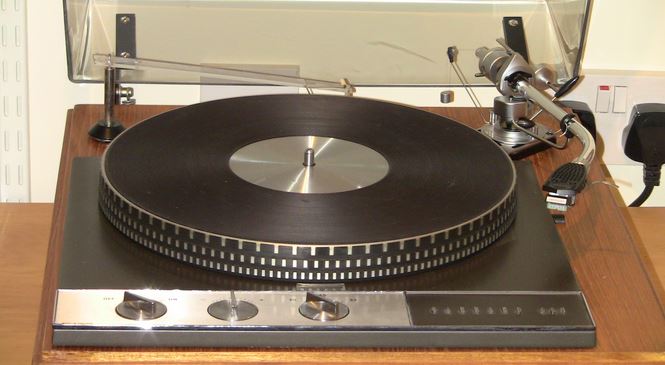
Everything was lightweight and flimsy and rattling. No wonder people thought a bit of mass and rigidity might help. Previous Decca designs were built like the proverbial Brick Outhouse for good mechanical loading and low stored energy.
I think I have covered electrical loading, which also matters.
One of my favourite tweaks was to acoustically isolate the turntable from the speakers too. Because the pick-up is a microphone and picks up all nearby sounds and footsteps. Use long speaker cables or put the turntable in another room, or mounted on a solid shelf on the more solid sidewall. Obvious really. Putting a speaker next to a turntable is a very bad thing to do.
I showed you this MM Shure V15 III cartridge in an SME 3009II tonearm. Actually a step backwards in the ART, whatever your view of MM cartridges. SME later tried silicone damping and a few other things.
Everything was lightweight and flimsy and rattling. No wonder people thought a bit of mass and rigidity might help. Previous Decca designs were built like the proverbial Brick Outhouse for good mechanical loading and low stored energy.
I think I have covered electrical loading, which also matters.
One of my favourite tweaks was to acoustically isolate the turntable from the speakers too. Because the pick-up is a microphone and picks up all nearby sounds and footsteps. Use long speaker cables or put the turntable in another room, or mounted on a solid shelf on the more solid sidewall. Obvious really. Putting a speaker next to a turntable is a very bad thing to do.
Last edited:
You are confusing impedance with char impedance Sqrt(R+L/(G+C))I can only tell you what I know.
Cartridges, broadly, fall into those high-output types designed for 47k amplifier load and those designed for low voltage output to about 100 ohms load. Some MC designs (like the Decca ffss) are high-output and can work into 47k preamps.
This matters because you also have to consider the effects of the cable too. A typical 1m RCA phono cable is about 100 ohms characteristic impedance. This means that when it is terminated in 100 ohms resistance, it should behave EXACTLY as a 100 ohm load to the cartridge source.
Terminate it in 47k, and it looks like 47k plus 200pF capacitance. This ignores the fact that a lot of preamps add a little bit of input capacitance too.
Char imp is not dependant on length once L is bigger as R and C bigger as G, usually above audio range, see blue line in image below.
So terminating the cable with 100R is rather useless, apart from the fact that at low frequencies there are no reflections to take care of since wavelength is much, much beyond the cable length.
There is no feedback measurable from the external cartridge loading to the cantilever.But what happens when you reduce the pre-amp resistance is the cartridge is working harder to move, being more loaded by the termination. Thus the load resistance affects the sound, and also affects the mechanical resistance of the stylus cantilever, which must increase wear and tear. This is what you are playing around with.
No harder working, no more wear no affecting of sound other then introducing another pole in the FR, eventually compensable in the Riaa correction.
Hans
Attachments
Hans, don't do that! 
I know exactly what am talking about with cable impedance. You and I calculated the lumped L and C parameters for a phono or loudspeaker cable a while back. What was it? 500-1000 pF and some inductance for 5m of 100 ohm cable. 100-200 pF is tiny for a 1m cable. Problem is MM cartridges and microphones have HUGE inductance. Its the product that matters
Long runs of RCA phono are very bad indeed into 47k. The capacitance rolls off the top end of a microphone very badly indeed. I know this, because I once had the "Brainwave" of putting the amplifier at the back of the Venue and running a 20m cable to it from the Stage which had standard Shure high output microphones, so I could hear the mix better. Knew little about preferred pro-audio 600 ohm balanced line at the time.
The top end of the voices went completely missing! Along with terrible hum issues. A learning experience. I subsequently worked on HF 50 ohm submarine telephone cables. Characteristic impedance was crucial for matching. Otherwise you got group delay and echoes. Now I know there is a lot of debate how relevant characteristic impedance is at Audio frequencies, but lumped capacitance, inductance and the load resistance matters. And I do know what skin effect at HF is.
And if you think electrical loading doesn't affect a mechanical transducer, simply try tapping your bass cone on a speaker with the speaker input open-circuit and shorted with a wire. The sound changes entirely. A Child of Ten can do this.
I know exactly what am talking about with cable impedance. You and I calculated the lumped L and C parameters for a phono or loudspeaker cable a while back. What was it? 500-1000 pF and some inductance for 5m of 100 ohm cable. 100-200 pF is tiny for a 1m cable. Problem is MM cartridges and microphones have HUGE inductance. Its the product that matters
Long runs of RCA phono are very bad indeed into 47k. The capacitance rolls off the top end of a microphone very badly indeed. I know this, because I once had the "Brainwave" of putting the amplifier at the back of the Venue and running a 20m cable to it from the Stage which had standard Shure high output microphones, so I could hear the mix better. Knew little about preferred pro-audio 600 ohm balanced line at the time.
The top end of the voices went completely missing! Along with terrible hum issues. A learning experience. I subsequently worked on HF 50 ohm submarine telephone cables. Characteristic impedance was crucial for matching. Otherwise you got group delay and echoes. Now I know there is a lot of debate how relevant characteristic impedance is at Audio frequencies, but lumped capacitance, inductance and the load resistance matters. And I do know what skin effect at HF is.
And if you think electrical loading doesn't affect a mechanical transducer, simply try tapping your bass cone on a speaker with the speaker input open-circuit and shorted with a wire. The sound changes entirely. A Child of Ten can do this.
Last edited:
There is no feedback measurable from the external cartridge loading to the cantilever.
Which has been shown several ways, both by calculating the efficiency of the generator (by LD) and George putting 5V across a MM cartridge.
It's OK to admit you are wrong. Consider a bass loudspeaker flapping about uncontrollably in Air. Big excursion yes?
Now give it the same signal, but immersed in water. It won't move much, will it? Because it is more mechanically loaded. The same goes for electrical loading. The harder it has to push, the less it moves. Simple.
Now give it the same signal, but immersed in water. It won't move much, will it? Because it is more mechanically loaded. The same goes for electrical loading. The harder it has to push, the less it moves. Simple.
Sorry but again incomparable, 50R coax transmission line for phone at HF and interlink for LF audio.Hans, don't do that!
I know exactly what am talking about with cable impedance. You and I calculated the lumped L and C parameters for a phono or loudspeaker cable a while back. What was it? 500-1000 pF and some inductance for 5m of 100 ohm cable. 100-200 pF is tiny for a 1m cable. Problem is MM cartridges and microphones have HUGE inductance. Its the product that matters
Long runs of RCA phono are very bad indeed into 47k. The capacitance rolls off the top end of a microphone very badly indeed. I know this, because I once had the "Brainwave" of putting the amplifier at the back of the Venue and running a 20m cable to it from the Stage which had standard Shure high output microphones, so I could hear the mix better. Knew little about preferred pro-audio 600 ohm balanced line at the time.
The top end of the voices went completely missing! Along with terrible hum issues. A learning experience. I subsequently worked on HF 50 ohm submarine telephone cables. Characteristic impedance was crucial for matching. Otherwise you got group delay and echoes. Now I know there is a lot of debate how relevant characteristic impedance is at Audio frequencies, but lumped capacitance, inductance and the load resistance matters. And I do know what skin effect at HF is.
And if you think electrical loading doesn't affect a mechanical transducer, simply try tapping your bass cone on a speaker with the speaker input open-circuit and shorted with a wire. The sound changes entirely. A Child of Ten can do this.
No transmission line technique is applicable in the audio range because of the wavelength, just take care of the total capacitance and eventually close the line with a lower resistance to damp the LC res. freq. between Lcart and C(cable + preamp).
This technique demands some knowledge on how to correct this in the Riaa amp, if not you will get a very distorted frequency response.
Hans
- Home
- Member Areas
- The Lounge
- Is this cartridge snake oil ?

